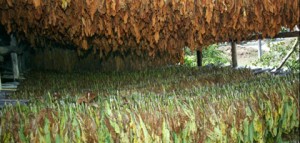Curing is a integral part of the cigar manufacturing process and is a rather lengthy and convoluted project. Curing typically begins as soon as the tobacco leaves are harvested whereupon they’re transported to a coast or kiln. These are large drying barns where the leaves will be intermittently stored. Curing barns come in a extremely diverse variety of styles but all have one thing in common, a large number of doors and windows to help regulate the air flow into and out of the building. The reason this surplus of openings is important is that a precise internal temperature is very important to dry out the leaves evenly. Once the leaves are transported to the curing barn, they’re individually and meticulously threaded around long wooden poles that’re evenly stacked or hung all around the barn to achieve optimal speed in the desiccation process as well as to keep air flowing.
Around 85% of green tobacco leaf’s weight is in water and thus the initial drying process is a fairly lengthy one, usually requiring around 3 to 8 weeks. After the initial drying process is completed, the tobacco leaves will have turned from their natural green hue to a muddy brown. Once this distinctive coloring is achieved the leaves are taken down from the drying bars and tied into small bundles, usually consisting of around twenty five leaves. These bundles are then transfered to sites called fermentation houses for the final steps in the curing process.
The bundles are then meticulously stacked on wooden palettes where they are intermittently sprayed with water to keep them just moist enough so they do not break during the rest of the process where the leaves are shaken to ensure that all moisture is removed. The bundles are then alternated regularly on the palettes until the leaves achieve a elastic consistency. The fermentation process takes about six weeks and when it’s done the leaves emit the wonderfully alluring aroma which is synonymous with a good cigar. The curing process is now complete and the leaves are now ready for the aging process after which point they’ll be cut, rolled and eventually turned into the small, sleek stogies every cigar aficionado enjoys.

